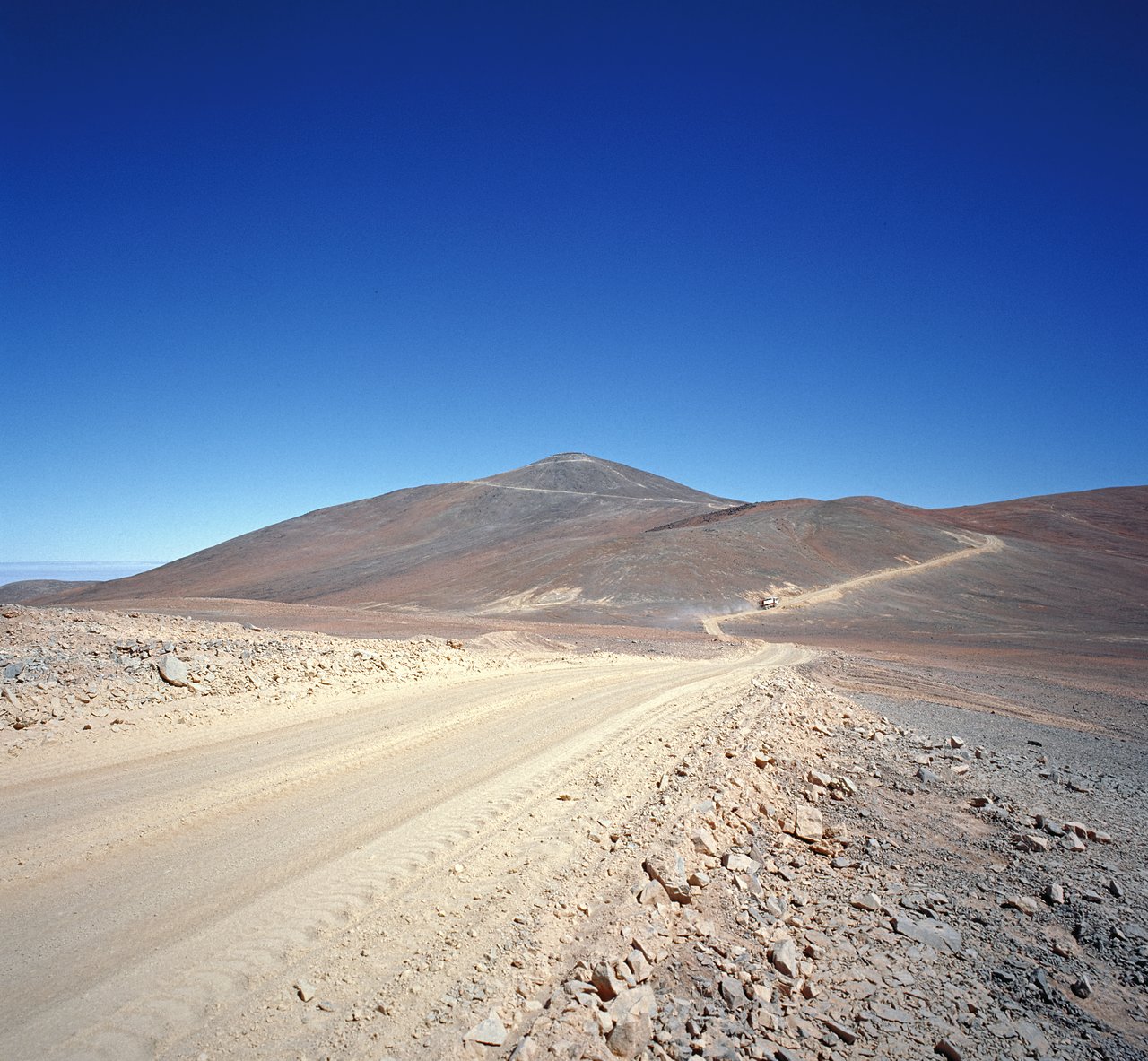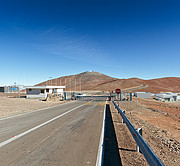Desde um caminho de terra batida até ao observatório líder mundial


O ESO faz 50 anos este ano e, para celebrar esta importante data, mostramos momentos do nosso passado. Uma vez por mês, durante todo o ano de 2012, publicamos uma Fotografia da Semana especial de comparação "Antes e Agora", onde mostramos como é que as coisas mudaram ao longo das décadas nos observatórios de La Silla e Paranal, nos gabinetes do ESO em Santiago do Chile e na Sede do ESO em Garching bei München, Alemanha.
Este par de fotografias mostra uma panorâmica da entrada do Observatório do Paranal, no norte do Chile, na direção do cume do Cerro Paranal, tal qual como o local era em 1987 e como é hoje em dia.
A região do Cerro Paranal foi pela primeira vez inspeccionada, como possível local para o futuro Very Large Telescope (VLT), em 1983 por uma equipe que incluía o então Diretor Geral do ESO, Lodewijk Woltjer (ver a revista The Messenger, nº 64, pág. 5-8 para mais informações). Em 1987 foi construída uma estrada de terra batida até ao cume e estabelecida nesse sítio uma estação permanente para monitorizar as condições do local. A fotografia histórica mostra uma imagem dessa época.
Os resultados dos testes do local foram extremamente bons - as condições eram claramente melhores do que as do Observatório de La Silla do ESO, como também as de outros locais que estavam sendo estudados para o mesmo efeito. Estes resultados levaram assim à decisão de colocar o VLT no Paranal, decisão essa que foi tomada pelo Conselho do ESO em dezembro de 1990 (ver eso9015).
Muito mudou no Paranal nos 25 anos desde que a fotografia histórica foi tirada. O cume da montanha foi nivelado e construiu-se uma estrada de boa qualidade, e claro, os telescópios do observatório foram também construídos. O observatório completo e totalmente operacional pode ser visto na fotografia atual. No cume encontram-se os quatro telescópios de 8.2 metros que compõem o VLT, assim como os quatro telescópios auxiliares menores, de 1.8 metros, utilizados para a interferometria. Encontra-se também instalado neste local o VLT Survey Telescope de 2.6 metros. Na região do portão foram erguidos muitos edifícios que formam o campo base do observatório. Para uma vista na direção oposta, do cimo da montanha para baixo, para o campo base, veja a Fotografia da Semana potw1230.
Links
- Imagem histórica
- Imagem atual
- Comparação lado a lado das imagens histórica e atual
Créditos
ESO
Sobre a comparação de imagens
| Id: | potw1232a |
| Data de divulgação: | 6 de Agosto de 2012 às 10:00 |
Imagens
Our use of Cookies
We use cookies that are essential for accessing our websites and using our services. We also use cookies to analyse, measure and improve our websites’ performance, to enable content sharing via social media and to display media content hosted on third-party platforms.
ESO Cookies Policy
The European Organisation for Astronomical Research in the Southern Hemisphere (ESO) is the pre-eminent intergovernmental science and technology organisation in astronomy. It carries out an ambitious programme focused on the design, construction and operation of powerful ground-based observing facilities for astronomy.
This Cookies Policy is intended to provide clarity by outlining the cookies used on the ESO public websites, their functions, the options you have for controlling them, and the ways you can contact us for additional details.
What are cookies?
Cookies are small pieces of data stored on your device by websites you visit. They serve various purposes, such as remembering login credentials and preferences and enhance your browsing experience.
Categories of cookies we use
Essential cookies (always active): These cookies are strictly necessary for the proper functioning of our website. Without these cookies, the website cannot operate correctly, and certain services, such as logging in or accessing secure areas, may not be available; because they are essential for the website’s operation, they cannot be disabled.
Functional Cookies: These cookies enhance your browsing experience by enabling additional features and personalization, such as remembering your preferences and settings. While not strictly necessary for the website to function, they improve usability and convenience; these cookies are only placed if you provide your consent.
Analytics cookies: These cookies collect information about how visitors interact with our website, such as which pages are visited most often and how users navigate the site. This data helps us improve website performance, optimize content, and enhance the user experience; these cookies are only placed if you provide your consent. We use the following analytics cookies.
Matomo Cookies:
This website uses Matomo (formerly Piwik), an open source software which enables the statistical analysis of website visits. Matomo uses cookies (text files) which are saved on your computer and which allow us to analyze how you use our website. The website user information generated by the cookies will only be saved on the servers of our IT Department. We use this information to analyze www.eso.org visits and to prepare reports on website activities. These data will not be disclosed to third parties.
On behalf of ESO, Matomo will use this information for the purpose of evaluating your use of the website, compiling reports on website activity and providing other services relating to website activity and internet usage.
Matomo cookies settings:
Additional Third-party cookies on ESO websites: some of our pages display content from external providers, e.g. YouTube.
Such third-party services are outside of ESO control and may, at any time, change their terms of service, use of cookies, etc.
YouTube: Some videos on the ESO website are embedded from ESO’s official YouTube channel. We have enabled YouTube’s privacy-enhanced mode, meaning that no cookies are set unless the user actively clicks on the video to play it. Additionally, in this mode, YouTube does not store any personally identifiable cookie data for embedded video playbacks. For more details, please refer to YouTube’s embedding videos information page.
Cookies can also be classified based on the following elements.
Regarding the domain, there are:
- First-party cookies, set by the website you are currently visiting. They are stored by the same domain that you are browsing and are used to enhance your experience on that site;
- Third-party cookies, set by a domain other than the one you are currently visiting.
As for their duration, cookies can be:
- Browser-session cookies, which are deleted when the user closes the browser;
- Stored cookies, which stay on the user's device for a predetermined period of time.
How to manage cookies
Cookie settings: You can modify your cookie choices for the ESO webpages at any time by clicking on the link Cookie settings at the bottom of any page.
In your browser: If you wish to delete cookies or instruct your browser to delete or block cookies by default, please visit the help pages of your browser:
Please be aware that if you delete or decline cookies, certain functionalities of our website may be not be available and your browsing experience may be affected.
You can set most browsers to prevent any cookies being placed on your device, but you may then have to manually adjust some preferences every time you visit a site/page. And some services and functionalities may not work properly at all (e.g. profile logging-in, shop check out).
Updates to the ESO Cookies Policy
The ESO Cookies Policy may be subject to future updates, which will be made available on this page.
Additional information
For any queries related to cookies, please contact: pdprATesoDOTorg.
As ESO public webpages are managed by our Department of Communication, your questions will be dealt with the support of the said Department.

